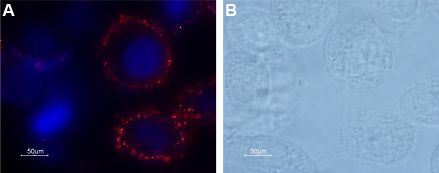Overview
- Peptide (C)KNESGLTEYRLVSINK, corresponding to amino acid residues 61-76 of human PAR-1 (Accession P25116). Extracellular, N terminal.

 Western blot analysis of human promyelocytic leukemia HL-60 (lanes 1 and 4), human T-cell leukemia Jurkat (lanes 2 and 5), and chronic myelogenous leukemia K562 (lanes 3 and 6) cell line lysates:1-3. Anti-Human PAR1 (F2R) (extracellular) Antibody (#APR-031), (1:200).
Western blot analysis of human promyelocytic leukemia HL-60 (lanes 1 and 4), human T-cell leukemia Jurkat (lanes 2 and 5), and chronic myelogenous leukemia K562 (lanes 3 and 6) cell line lysates:1-3. Anti-Human PAR1 (F2R) (extracellular) Antibody (#APR-031), (1:200).
4-6. Anti-Human PAR1 (F2R) (extracellular) Antibody, preincubated with Human PAR1/F2R (extracellular) Blocking Peptide (#BLP-PR031). Western blot analysis of human colon cancer HT-29 (lanes 1 and 3) and human Colo-205 colon cancer (lanes 2 and 4) cell line lysates:1,2. Anti-Human PAR1 (F2R) (extracellular) Antibody (#APR-031), (1:200).
Western blot analysis of human colon cancer HT-29 (lanes 1 and 3) and human Colo-205 colon cancer (lanes 2 and 4) cell line lysates:1,2. Anti-Human PAR1 (F2R) (extracellular) Antibody (#APR-031), (1:200).
3,4. Anti-Human PAR1 (F2R) (extracellular) Antibody, preincubated with Human PAR1/F2R (extracellular) Blocking Peptide (#BLP-PR031).
 Expression of PAR-1 in normal human breast and human breast carcinomaImmunohistochemical staining of paraffin-embedded human breast sections using Anti-Human PAR1 (F2R) (extracellular) Antibody (#APR-031), (1:100). PAR-1 staining is highly specific for epithelium-derived cells. A. In the normal resting breast, epithelial cells of the mammary ducts are visible using Histofine (pink). B. The breast carcinoma contains epithelium-derived malignant cells stained with DAB (brown). Hematoxilin is used as the counterstain.
Expression of PAR-1 in normal human breast and human breast carcinomaImmunohistochemical staining of paraffin-embedded human breast sections using Anti-Human PAR1 (F2R) (extracellular) Antibody (#APR-031), (1:100). PAR-1 staining is highly specific for epithelium-derived cells. A. In the normal resting breast, epithelial cells of the mammary ducts are visible using Histofine (pink). B. The breast carcinoma contains epithelium-derived malignant cells stained with DAB (brown). Hematoxilin is used as the counterstain.
 Cell surface detection of PAR-1 by indirect flow cytometry in live intact human MEG-01 megakaryocytic leukemia cells:___ Cells.
Cell surface detection of PAR-1 by indirect flow cytometry in live intact human MEG-01 megakaryocytic leukemia cells:___ Cells.
___ Cells + goat-anti-rabbit-FITC.
___ Cells + Anti-Human PAR1 (F2R) (extracellular) Antibody (#APR-031), (2.5μg) + goat-anti-rabbit-FITC. Cell surface detection of PAR-1 by indirect flow cytometry in live intact human A-875 Melanoma cells:___ Cells.
Cell surface detection of PAR-1 by indirect flow cytometry in live intact human A-875 Melanoma cells:___ Cells.
___ Cells + goat-anti-rabbit-FITC.
___ Cells + Anti-Human PAR1 (F2R) (extracellular) Antibody (#APR-031), (2.5μg) + goat-anti-rabbit-FITC. Cell surface detection of PAR-1 by indirect flow cytometry in live intact human MDA-MB-231 breast adenocarcinoma cell line:___ Cells.
Cell surface detection of PAR-1 by indirect flow cytometry in live intact human MDA-MB-231 breast adenocarcinoma cell line:___ Cells.
___ Cells + goat-anti-rabbit-APC.
___ Cells + Anti-Human PAR1 (F2R) (extracellular) Antibody (#APR-031), (2.5μg) + goat-anti-rabbit-APC.
 Expression of PAR-1 in human prostate PC-3 cell lineCell surface detection of PAR-1 in human prostate PC-3 cell line. A. Live intact PC-3 cells were stained with Anti-Human PAR1 (F2R)(extracellular) Antibody (#APR-031), (1:50), followed by goat-anti-rabbit-AlexaFluor-555 secondary antibody (red staining). Nuclei were visualized using the cell-permeable dye Hoechst 33342 (blue). B. Live view of the same field as A.
Expression of PAR-1 in human prostate PC-3 cell lineCell surface detection of PAR-1 in human prostate PC-3 cell line. A. Live intact PC-3 cells were stained with Anti-Human PAR1 (F2R)(extracellular) Antibody (#APR-031), (1:50), followed by goat-anti-rabbit-AlexaFluor-555 secondary antibody (red staining). Nuclei were visualized using the cell-permeable dye Hoechst 33342 (blue). B. Live view of the same field as A.
- MacFarlane, S.R. et al. (2001) Pharmacol. Rev. 53, 245.
- Hollenberg, M.D. et al. (2002) Pharmacol. Rev. 54, 203.
- Ossovskaya, V.S. et al. (2004) Physiol. Rev. 84, 579.
- Arora, P. et al. (2007) J. Cell Sci. 120, 921.
Protease-activated receptor 1 (PAR-1) belongs to a family of four G protein-coupled receptors (PAR1-4) that are activated as a result of proteolytic cleavage by certain serine proteases, hence their name. In this novel modality of activation, a specific protease cleaves the PAR receptor within a defined sequence in its extracellular N-terminal domain. This results in the creation of a new N-terminal tethered ligand, which subsequently binds to a site in the second extracellular loop of the same receptor. This binding results in the coupling of the receptor to G proteins and in the activation of several signal transduction pathways.1-3
Different PARs are activated by different proteases. Hence, PAR-1 is activated by thrombin (and is in fact also known as the thrombin receptor), as are PAR-3 and PAR-4, while PAR-2 is activated by trypsin.1-3 PAR-1 can be also cleaved and activated by other proteases such as plasmin, Factor Xa, cathepsin G, and others.
The intramolecular nature of PAR activation and the continuous presence of the tethered ligand that cannot diffuse away imply the existence of several mechanisms for the rapid termination of PAR signaling. Indeed, following receptor activation, there is rapid phosphorylation of the C-terminal end of the receptor, followed by receptor internalization and degradation. In addition, several proteases can cleave away the tethered ligand, thereby “disarming” the PAR.1-3
PAR-1 signals through several G proteins including Gaq, Gai, and Ga12/13, resulting in the activation of several transduction pathways including intracellular Ca2+ mobilization, Rho and Rac signaling, and MAPK activation.1-3
PAR-1 is expressed in several cell types including platelets, leukocytes, vascular endothelial cells, gastrointestinal epithelial cells, myocytes, and neurons. The best studied physiological function of PAR-1 is its involvement in the coagulation cascade. Thrombin, the preeminent ligand of PAR-1, activates the receptor on the surface of platelets, hence inducing platelet aggregation, granular secretion, and procoagulant activity. PAR-1 also plays a crucial role in vascular ontogenesis. Accordingly, PAR-1 knockout mice show bleeding at multiple sites and usually die at mid-gestation.1-3
PAR-1 also plays important roles in tumor growth and metastasis. PAR-1 is upregulated in several human cancers as are several proteases such as plasmin and matrix metalloproteases (MMPs) that act as PAR-1 ligands, thereby creating an autocrine loop. PAR-1 activation in cancer cells transmits mitogenic signals through the activation of the erk1/2 pathway and is involved in tumor spread via its pro-angiogenic activity.4
Application key:
Species reactivity key:
Anti-Human PAR1 (F2R) (extracellular) Antibody (#APR-031) is a highly specific antibody directed against an epitope of human protease-activated receptor-1. The antibody can be used in western blot, immunohistochemistry, immunocytochemistry, and live cell flow cytometry applications. It has been designed to recognize PAR-1 from human samples.
Applications
Citations
- Human tendon sections (1:100).
Christensen, J. et al. (2015) Mol. Pain 11, 13.
- Human culured tenocytes (1:100).
Christensen, J. et al. (2015) Mol. Pain 11, 13.
